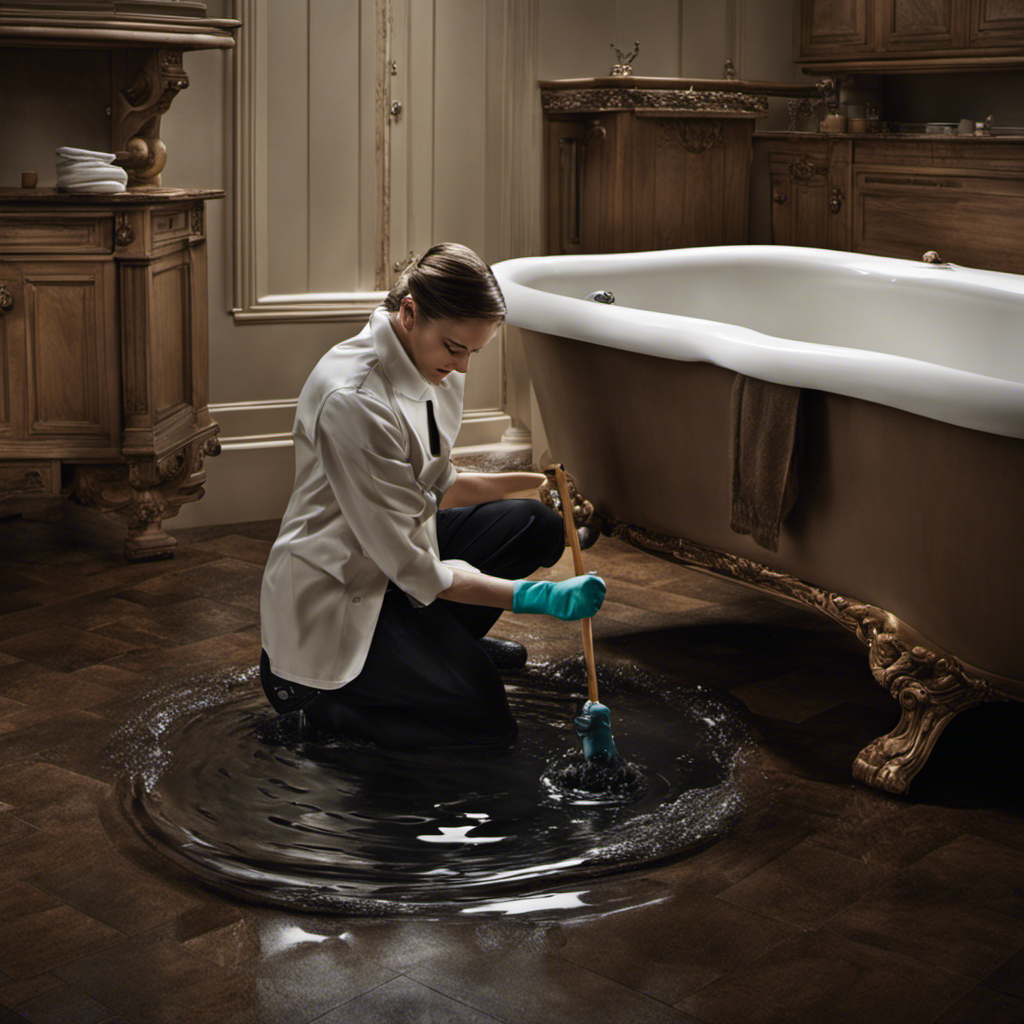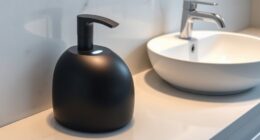Are you tired of dealing with a clogged bathtub drain and standing water? Well, you’re in luck! In this step-by-step guide, we’ll show you how to unclog your bathtub drain using simple tools and supplies that you probably already have at home.
Say goodbye to the frustration and inconvenience of a clogged drain. Follow these easy steps and get your bathtub back to its free-flowing glory in no time.
Let’s dive in!
Key Takeaways
- Slow drainage and standing water are common signs of a clogged bathtub drain.
- There are various tools and supplies available for unclogging a bathtub drain, including a plunger, plumber’s snake, baking soda and vinegar, chemical drain cleaner, and rubber gloves.
- Different equipment options for unclogging include chemical drain cleaner, enzyme-based drain cleaner, hydrogen peroxide, baking soda and vinegar, and a plunger.
- To prevent future clogs, it is important to use a drain strainer, regularly clean it, pour hot water down the drain, avoid dumping solid materials, and use natural and eco-friendly drain cleaners.
Understanding the Common Causes of Bathtub Drain Clogs
Understanding the common causes of bathtub drain clogs can help you prevent future blockages. By being aware of the signs and characteristics of a clogged bathtub drain, you can take early action to prevent further complications.
The most common signs of a clogged bathtub drain include slow drainage, standing water, unpleasant odors, and gurgling sounds. Identifying a stubborn bathtub clog can be done by observing if the water drains slowly or not at all, even after using basic unclogging methods. This could indicate a more severe blockage that requires additional measures to clear.
Now that you know the common causes and signs of a clogged bathtub drain, it’s time to gather the necessary tools and supplies to address the issue effectively.
Gather the Necessary Tools and Supplies
When it comes to unclogging drains, having the right tools and supplies is essential. To effectively tackle clogs, you’ll need a few key items in your arsenal.
From plungers and drain snakes to chemical drain cleaners and protective gloves, these must-have tools will help you successfully clear your clogged drains.
Essential Tools and Supplies
To unclog your bathtub drain with standing water, you’ll need a plunger, a plumber’s snake, and some baking soda and vinegar. Before you start, make sure you have these essential tools and supplies on hand.
A plunger is great for dislodging clogs by creating suction and pressure.
The plumber’s snake, also known as a drain auger, can reach deep into the drain to remove stubborn blockages.
Baking soda and vinegar are a natural alternative to harsh chemical drain cleaners. Simply pour half a cup of baking soda down the drain, followed by half a cup of vinegar. Cover the drain and let the mixture sit for 30 minutes before flushing with hot water.
These tools and supplies will help you tackle different types of clogs and provide alternative methods for unclogging bathtub drains.
Proper Equipment for Clogging
Having the right equipment is essential for effectively dealing with clogs in your bathtub. Clogging prevention and choosing the right drain cleaner are key factors in maintaining a clear and functional drain. To help you make informed decisions, here is a table outlining the different types of drain cleaners and their benefits:
| Drain Cleaner | Benefits |
|---|---|
| Chemical | Quick and easy to use |
| Enzyme-based | Environmentally friendly |
| Hydrogen Peroxide | Effective for organic clogs |
| Baking Soda and Vinegar | Natural and non-toxic |
| Plunger | Simple and inexpensive |
Must-Have Drain Unclogging Items
You’ll need a plunger, chemical drain cleaner, and baking soda and vinegar to effectively tackle clogs in your bathtub. Here are five must-have drain unclogging items to help you get the job done:
-
Plunger: This tool creates suction to dislodge clogs when you push and pull it over the drain.
-
Chemical Drain Cleaner: These cleaners contain powerful chemicals that dissolve clogs and clear the drain.
-
Baking Soda and Vinegar: A natural and effective alternative to chemical cleaners, these ingredients create a fizzy reaction that helps break down clogs.
-
Drain Snake: This long, flexible tool is inserted into the drain to physically remove clogs.
-
Rubber Gloves: Protect your hands from any chemicals or debris while working on unclogging your drain.
Remove the Bathtub Drain Cover
When it comes to unclogging your bathtub drain, one of the first steps you need to take is removing the drain cover. This is an important step because it allows you to access the clog and effectively remove it.
To remove the drain cover, you will need to use specific techniques, such as using a screwdriver or a drain key, depending on the type of drain cover you have.
Once you have successfully removed the drain cover, you can then move on to the next step of unclogging your bathtub drain and preventing future clogs.
Drain Cover Removal Techniques
To remove the drain cover, simply use a screwdriver to unscrew it counterclockwise. Here are some techniques for removing rusted drain covers:
- Apply penetrating oil: Spray penetrating oil on the screws and let it sit for a few minutes to loosen the rust.
- Use a rubber mallet: Gently tap the drain cover with a rubber mallet to break the rust seal.
- Heat the screws: Use a heat gun or a hairdryer to heat the screws, which will expand the metal and make it easier to remove.
- Try vinegar: Soak a cloth in vinegar and wrap it around the screws. Let it sit overnight to dissolve the rust.
- Use a drill: If all else fails, carefully drill out the screws to remove the drain cover.
Remember to regularly clean and maintain your drain covers to prevent rust buildup and ensure proper drainage.
Preventing Future Clogs
Now that you’ve learned how to remove the drain cover, it’s time to focus on preventing future clogs and maintaining drainage efficiency. By following these steps, you can keep your bathtub drain free from blockages and ensure smooth water flow.
-
Use a drain strainer: Install a drain strainer over your bathtub drain to catch hair, soap residue, and other debris before they go down the drain.
-
Regular cleaning: Clean your drain strainer regularly by removing any trapped debris. Dispose of the debris in the trash.
-
Hot water flush: Once a week, pour a pot of hot water down the drain to flush away any accumulated grease or soap scum.
-
Avoid dumping debris: Avoid dumping coffee grounds, food scraps, or other solid materials down the drain as they can cause blockages.
-
Chemical-free solutions: Use natural and eco-friendly drain cleaners like baking soda and vinegar to break down any buildup in the drain.
Use a Plunger to Try and Unclog the Drain
First, grab a plunger and position it over the drain to try and unclog it. This is the most common and effective method for unclogging a bathtub drain with standing water. Push the plunger up and down vigorously to create suction and dislodge any blockages.
If this method doesn’t work, there are alternative drain cleaning methods you can try:
-
Use a wire hanger: Straighten out a wire hanger and create a small hook at one end. Insert the hook into the drain and try to fish out any debris or hair that may be causing the clog.
-
Baking soda and vinegar: Pour half a cup of baking soda into the drain, followed by half a cup of vinegar. Let it fizz for a few minutes, then pour hot water down the drain to flush away the clog.
-
Boiling water: Boil a kettle of water and pour it directly into the drain. The hot water can help dissolve any greasy buildup that may be causing the clog.
-
Wet and dry vacuum: If you have access to a wet and dry vacuum, use it to suck out the clog from the drain.
-
Chemical drain cleaners: Use caution when using chemical drain cleaners, as they can be harmful to your pipes. Follow the instructions carefully and avoid using them too frequently.
Remember to try these alternative methods if the plunger doesn’t work, but if the clog persists, it may be best to call a professional plumber to avoid causing further damage to your plumbing system.
Attempt to Remove the Clog Using a Plumbing Snake
To effectively remove the clog using a plumbing snake, you’ll need to follow a few key techniques.
First, insert the snake into the drain and rotate it clockwise to break up the clog.
Then, gradually pull the snake out, while continuing to rotate it, to ensure all debris is cleared.
Effective Snake Techniques
You’ll want to make sure you select the right type of snake for your bathtub drain. There are various snake alternatives available that can effectively clear clogs in your drain. Here are some techniques to consider:
-
Use a manual snake: This handheld tool allows you to manually rotate the snake to break up the clog and pull it out.
-
Try a power snake: This electric tool uses a motor to rotate the snake and provide more power for stubborn clogs.
-
Opt for a zip-it tool: This long plastic strip with barbs can be inserted into the drain to catch hair and other debris.
-
Consider natural drain cleaners: Mix baking soda and vinegar to create a foaming reaction that can break up clogs.
-
Use enzyme-based cleaners: These cleaners contain bacteria that eat away at organic matter causing clogs.
Preventing Future Clogs
One way to avoid future clogs is by regularly cleaning your bathtub drains with a mixture of baking soda and vinegar.
Preventing future clogs is essential for the proper functioning of your drain system. Regular drain maintenance helps in keeping the drains free from debris and build-up that can lead to blockages.
It is important to understand the importance of drain maintenance to prevent costly repairs and inconveniences caused by clogged drains. By following these simple steps, you can prevent future clogs and ensure smooth drainage in your bathtub.
First, remove any visible debris from the drain using a pair of gloves or tweezers. Then, pour half a cup of baking soda down the drain followed by half a cup of vinegar.
Cover the drain with a plug and let the mixture sit for about 30 minutes. Afterward, pour hot water down the drain to flush away any remaining residue.
Repeat this process every month to keep your bathtub drains clog-free.
Create a Homemade Drain Cleaner Solution
Mix baking soda and vinegar in a bowl to create a homemade drain cleaner solution. This solution is an effective alternative to commercial drain cleaners and uses natural ingredients. Here are some benefits of using a homemade drain cleaner:
- It is eco-friendly and safe for the environment.
- It does not contain harsh chemicals that can damage your pipes.
- It is cost-effective and can save you money.
- It can be easily made using ingredients that are commonly found in your kitchen.
- It is gentle yet powerful enough to unclog most drains.
Once you have mixed the baking soda and vinegar, it will create a fizzing reaction. This reaction helps to break down the clog in your drain. Now, let’s move on to the next step and pour the drain cleaner solution down the clogged drain.
Pour the Drain Cleaner Solution Down the Clogged Drain
After creating the homemade drain cleaner solution, pour it down the clogged drain to begin breaking down the clog.
Understanding drain blockage and alternative drain cleaning methods can help you effectively tackle this issue.
To pour the solution, start by removing any visible debris or hair from the drain opening using a pair of gloves or tweezers.
Then, carefully pour the homemade drain cleaner solution down the drain, making sure to cover the entire area.
Allow the solution to sit in the drain for about 30 minutes to an hour, depending on the severity of the clog.
During this time, the solution will work to break down the blockage, clearing the way for water to flow freely again.
Wait for the Solution to Work Its Magic
After pouring the drain cleaner solution down the clogged drain, it’s time to wait for the solution to work its magic. This step is crucial as it allows the chemicals to break down the clog and clear the blockage. The wait time can vary depending on the type of drain cleaner used and the severity of the clog. However, it is generally recommended to wait for at least 15 minutes to give the solution enough time to dissolve the debris and unclog the drain.
During this time, it’s important to avoid using the bathtub or adding any additional substances to the drain. This will ensure the effectiveness of the drain cleaner and maximize its results.
Here are some important points to remember during the waiting period:
- Be patient and allow the drain cleaner to do its job.
- Avoid using the bathtub or running water during this time.
- Refrain from adding any other substances or chemicals to the drain.
- Follow the instructions provided by the drain cleaner manufacturer for the recommended wait time.
- If the clog persists after the specified wait time, you may need to repeat the process or consider using a different method to unclog the drain.
Flush the Drain With Hot Water
During the waiting period, it’s important to let the drain cleaner work its magic before flushing the drain with hot water. This step will help to ensure that any remaining clogs or debris are cleared from the drain.
To effectively flush the drain with hot water, follow these steps:
- Fill a large pot or kettle with hot water.
- Carefully pour the hot water down the drain, ensuring that it reaches the clog.
- Allow the hot water to flow through the drain for a few minutes, helping to break up any remaining blockages.
- Repeat this process several times, if necessary, to fully flush the drain.
- Consider using alternative solutions such as vinegar and baking soda or a plunger if the clog persists.
Test the Drain to See if It’s Unclogged
To see if it’s cleared, you can test the drain by running some water through it. Testing the drain’s water flow is an essential step in troubleshooting the drain issue. Follow these steps to properly test the drain:
-
Turn on the faucet and let water flow into the bathtub.
-
Observe the water as it drains. If the water flows freely and quickly without any backup or standing water, then the drain is likely unclogged.
-
If the water drains slowly or if it starts to back up, then the drain may still be clogged. In this case, you can try using a plunger or a drain snake to remove the clog.
-
After attempting to unclog the drain, repeat the test to see if the water flow has improved.
Prevent Future Clogs With Regular Maintenance
To prevent future clogs, make sure you regularly maintain your drains. Regular maintenance is essential for keeping your drains clean and functioning properly. By taking the time to clean your drains on a regular basis, you can avoid the hassle and expense of dealing with clogs and backups.
Regular maintenance benefits include:
- Preventing clogs: By removing debris and buildup from your drains, you can prevent clogs from forming in the first place.
- Reducing odors: Regular cleaning helps eliminate unpleasant odors caused by trapped food particles and bacteria.
- Improving water flow: Clean drains allow water to flow freely, preventing slow drains and backups.
Importance of drain cleaning cannot be overstated. Neglecting drain maintenance can lead to costly repairs and inconveniences. By following a simple routine of regular maintenance, you can keep your drains clear and avoid future clogs.
| Regular Maintenance | Benefits |
|---|---|
| Remove debris | Prevent clogs and backups |
| Use natural cleaners | Reduce chemical buildup |
| Flush drains with hot water | Eliminate odors |
| Install drain screens | Catch hair and debris |
| Schedule professional inspections | Identify potential issues |
Make regular drain maintenance a part of your routine to ensure a smooth-running plumbing system.
Frequently Asked Questions
How Do I Know if My Bathtub Drain Is Clogged?
You can easily identify a clogged bathtub drain by noticing slow drainage, water pooling around the drain, and unpleasant odors. Regularly cleaning your drain and using a mesh drain cover can help prevent clogs.
Can I Use a Plunger to Unclog a Bathtub Drain With Standing Water?
Yes, you can use a plunger to unclog a bathtub drain with standing water. First, try plunging vigorously to create suction. If that doesn’t work, consider using baking soda and vinegar or a drain auger.
Is It Safe to Use a Plumbing Snake on My Bathtub Drain?
Using a plumbing snake on a bathtub drain is generally safe. Pros include effective removal of clogs and versatility. However, common mistakes to avoid are using too much force and causing damage to the pipes.
What Homemade Drain Cleaner Solution Can I Use to Unclog My Bathtub Drain?
To unclog your bathtub drain with standing water, you can try using a homemade drain cleaner solution. This option has its pros and cons compared to chemical drain cleaners. Let’s explore the ingredients and steps involved.
How Often Should I Perform Regular Maintenance to Prevent Future Clogs in My Bathtub Drain?
To prevent future clogs in your bathtub drain, perform regular preventative maintenance. This includes using a homemade drain cleaner solution and scheduling professional drain cleaning. Regular maintenance helps keep your drain clear and functioning properly.
Conclusion
Now that you’ve gathered the necessary tools and supplies, removed the bathtub drain cover, and attempted to unclog the drain using a plunger and plumbing snake, it’s time to wait for the solution to work its magic.
This is the moment of anticipation as you eagerly hope that the clog will disappear and the water will start draining freely. But remember, patience is key.
Once the waiting period is over, flush the drain with hot water and test it to see if it’s finally unclogged. The moment of truth is just around the corner, so stay tuned!










